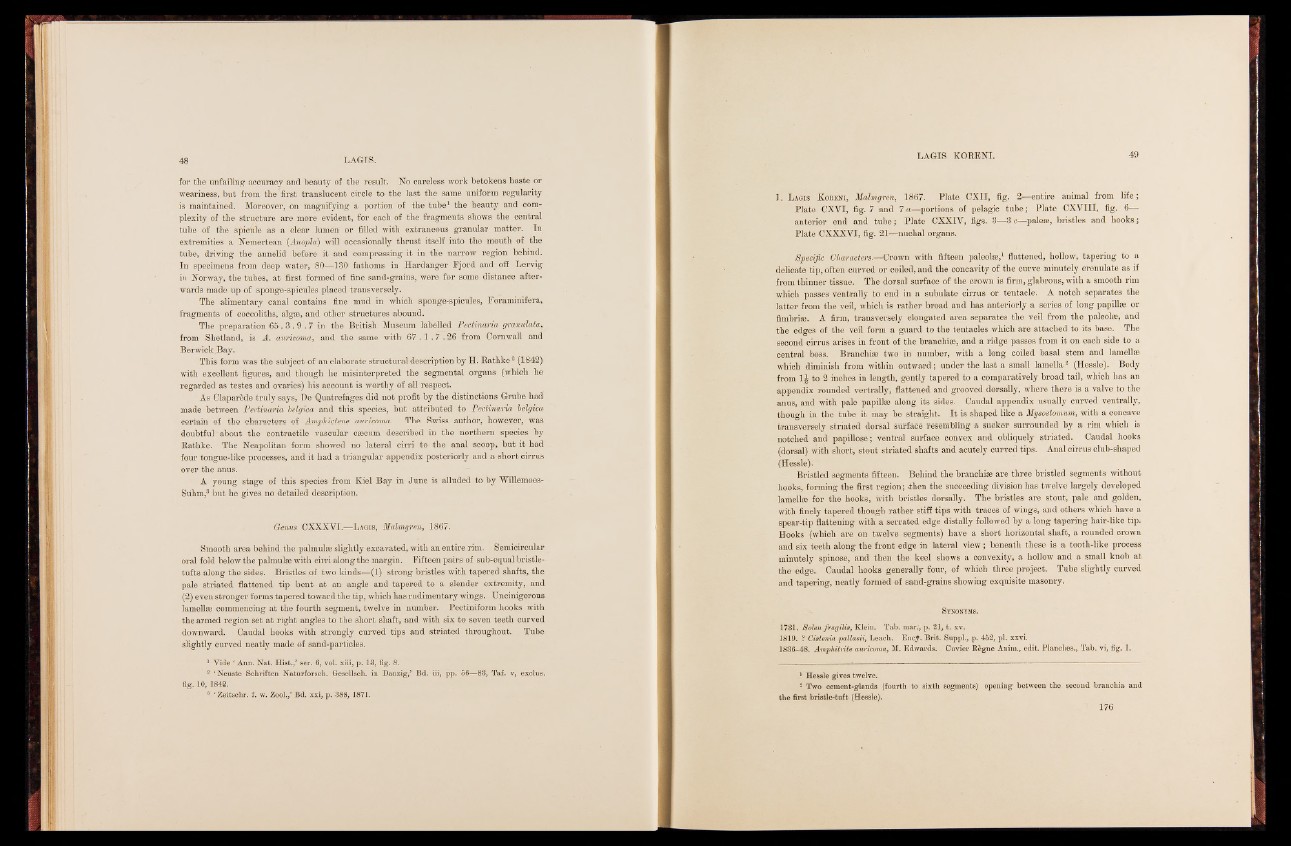
for the unfailing accuracy and beauty of the result. No careless work betokens haste or
weariness, byit from the first translucent circle to the last the same uniform regularity
is maintained. Moreover, on magnifying a portion of the tube1 the beauty and complexity
of the structure are more evident, for each of the fragments shows the central
tube of the spicule as a clear lumen or filled with extraneous granular matter. In
extremities a Nemertean (Anopla) will occasionally thrust itself into the mouth of the
tube, driving the annelid before it and compressing it in the narrow region behind.
In specimens from deep water, 80—130 fathoms in JEardanger Fjord and off Lervig
in Norway, the tubes, at first formed of fine sand-graifis, were for some distance afterwards
made up of sponge-spicules placed transversely.
The alimentary canal contains fine mud in which sponge-spicules, Foraminifera,
fragments of coccoliths, algæ, and other structures abound.
The preparation 6 5 .3 .9 .7 in the British Museum labelled Pectinaria granulata,
from Shetland, is A. auricoma, and the same with 6 7.1 .7 .2 6 from Cornwall and
Berwick,Bay.
This form was the subject of an elaborate structural description by H. Rathke 2 3 * (1842)
with excellent figures, and though he misinterpreted the segmental organs (which he
regarded as testes and ovaries) his account is worthy of all respect.
As Claparède truly says, Be Quatrefàges did not profit by the distinctions G-rube had
made between Pectinaria belgica and this species, but attributed to Pectinaria belgica
certain of the characters of Amphictene awricoma. The Swiss author, however, was
doubtful -about the contractile vascular cæcum described in the northern species by
Rathke. The Neapolitan form showed no lateral cirri to the anal scoop, but it had
four tongue-like processes, and it had a triangular appendix posteriorly and a short cirrus
over the anus.
A young stage of this species from Kiel Bay in June is alluded to by Willemoes-
Siihm,8 but he gives no detailed description.
Genus CXXXVI.—L agis, Malmgren, 1867.
Smooth area behind the palmulse slightly excavated, with an entire rim. Semicircular
oral fold below the palmulse with cirri along the margin. Fifteen pairs of sub-equal bristle-
tufts along the sides. Bristles of two kinds—(1) strong bristles with tapered shafts, the
pale striated flattened tip bent at an angle and tapered to a slender extremity, and
(2) even stronger forms tapered toward the tip, which has rudimentary wings. Uncinigerous
lamellse commencing at the fourth segment, twelve in number. Pectiniform hooks with
the armed region set at right angles to the short shaft, and with six to seven teeth curved
downward. Caudal hooks with strongly curved tips and striated throughout. Tube
slightly curved neatly made of sand-particles.
1 Tide ‘ Ann. Nat. Hist./ sex*. 6, vol. xiii, p. 13, fig. 8.
3 ‘Neuste Schi’iften Naturforsch. Gesellsch. in Danzig/ Bd. iii, pp. 56—83, Taf. v, exclus.
fig. 10, 1842.
8 ‘Zeitschr. f. w. Zool./ Bd, xxi, p. 388, 1871.
]. Lagis Koreni, Malmgren, 1867. Plate CXII, fig. 2—entire animal from life;
Plate CXVI, fig. 7 and 7 ^-portions of pelagic tube; Plate CXVIII, fig. 6—
anterior end and tube; Plate CXX1V, figs. 3—3 c—palese, bristles and hooks;
Plate CXXXVI, fig. 21—nuchal organs.
Specific Characters.—Crown with fifteen paleolse,1 flattened, hollow, tapering to a
delicate tip, often curved or coiled, and the concavity of the curve minutely crenulate as if
from thinner tissue. The dorsal surface of the crown is firm, glabrous, with a smooth rim
which passes ventrally to end in a subulate cirrus or tentacle. A notch separates the
latter from the veil, which is rather broad aud has anteriorly a series of long papillas or
fimbriae. A firm, transversely elongated area separates the veil from the paleolae, and
the edges of the veil form a guard to the tentacles which are attached to its base. The
second cirrus a-rises in front of the branchiae, and a ridge passes from it on each side to a
central boss. Branchiae two in number, with a long coiled basal stem and lamellae
which diminish from within outward; under the last a small lamella2 (Hessle). Body
from 1J to 2 inches in length, gently tapered to a comparatively broad tail, which has an
appendix rounded vertrally, flattened and grooved dorsally, where there is a valve to the
anus, and with pale papillae along its sides. Caudal appendix usually curved ventrally,
though in the tube it may be straight. It is shaped like a Mysostomum, with a concave
transversely striated dorsal surface resembling a sucker surrounded by a rim which is
notched and papillose; ventral surface convex and obliquely striated. Caudal hooks
(dorsal) with short, stout striated shafts and acutely curved tips. Anal cirrus club-shaped
(Hessle).
Bristled segments fifteen. Behind the branchiae are three bristled segments without
hooks, forming the first region; then the succeeding division has twelve largely developed
lamellae for the hooks, with bristles dorsally. The bristles are stout, pale and golden,
with finely tapered though rather stiff tips with traces of wings, and others which have a
spear-tip flattening with a serrated edge distally followed by a long tapering hair-like tip.
Hooks (which are on twelve segments) have a short horizontal shaft, a rounded crown
and six teeth along the front edge in lateral view; beneath these is a tooth-like process
minutely spinose, and then the keel shows a convexity, a hollow and a small knob at
the edge. Caudal hooks generally four, of which three project. Tube slightly curved
and tapering, neatly formed of sand-grains showing exquisite masonry.
Synonyms.
1731. Solen fragilis, Klein. Tab. mai*;, p. 21, t. xv.
1819. ? Cistenia •pallasii, Leach. Ency. Brit. Suppl., p. 452, pi. xxvi.
1836-48. Aviphitnte awricoma, M. Edwai’ds. Cuvier R5gne Anim., edit. Planches., Tab. vi, fig. 1.
1 Hessle gives twelve.
3 Two cement-glands (foui'th to sixth segments) opening between the second branchia and
the first bristle-tuft (Hessle).